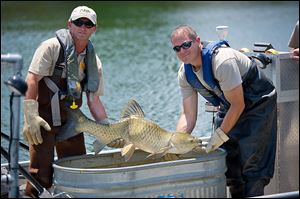
SANDUSKY RIVER
Asian carp species likely spawning in Erie’s basin
10/29/2013
Employees from the Michigan Department of Natural Resources check grass carp they captured in Marrs Lake near Onsted, Mich. Grass carp have been confirmed in the Sandusky River.
COLUMBUS — An extensive examination of four grass carp caught in the Sandusky River by a commercial fisherman late in 2012 has produced ominous results, indicating for the first time that this species of Asian carp is likely reproducing in the Lake Erie basin.
The fish were analyzed by a U.S. Geological Survey team, in collaboration with the Ohio Department of Natural Resources and Bowling Green State University.
The biologists studied the chemistry of bones in the heads of the fish and determined the four grass carp, which were at least a year old, had spent their entire lives in the Sandusky watershed. The study concluded the four grass carp were very likely the result of natural reproduction and were capable of becoming spawning adults.
Rich Carter, fish administrator for the Ohio Division of Wildlife, stressed that although grass carp are one of the four invasive species of Asian carp, they should not be confused with the potentially more destructive bighead and silver carp, which are threatening to enter the Great Lakes via the Mississippi River system.
The apparent successful reproduction of grass carp in the Lake Erie basin is of major concern, however, because it is seen as an indicator that the other species of invasive Asian carp also might be able to reproduce in those waters.
“These findings are significant because they confirm recent USGS research indicating that shorter rivers, like the Sandusky, are potential spawning sites for grass carp and other Asian carps as well,” USGS scientist Duane Chapman said.
The spawning requirements of silver, bighead, and black carp are similar to those needed by grass carp. In some areas of the Mississippi River basin, silver and bighead carp have reached very high densities, making up as much as 80 percent of the biomass.
Where they are present, bighead and silver carp compete directly with native fish for microscopic plankton, and are therefore a more serious threat to the world-class sport fishery on the Great Lakes. Grass carp eat aquatic vegetation, and they were brought to the United States in the 1960s to help control the growth of that vegetation in ponds.
Should grass carp become widespread in the Great Lakes, these fish could imperil native fish and waterfowl, because their consumption of aquatic plants could threaten nesting and spawning areas and sites critical to the early development of native species of fish.
Mr. Carter said the study and the discovery of the likely reproduction of grass carp in the Lake Erie basin give biologists a foundation from which to work to address the issue before it becomes a much bigger problem.
“It’s an active collaboration of all the agencies, in an ‘all hands on deck’ mode, to evaluate what we know, and close any knowledge gaps,” he said.
Ohio and 42 other states allow the sale of sterile grass carp for use in controlling vegetation in ponds. Ohio law prohibits the importation or stocking of fertile grass carp.
Contact Blade outdoors editor Matt Markey at: mmarkey@theblade.com or 419-724-6068.